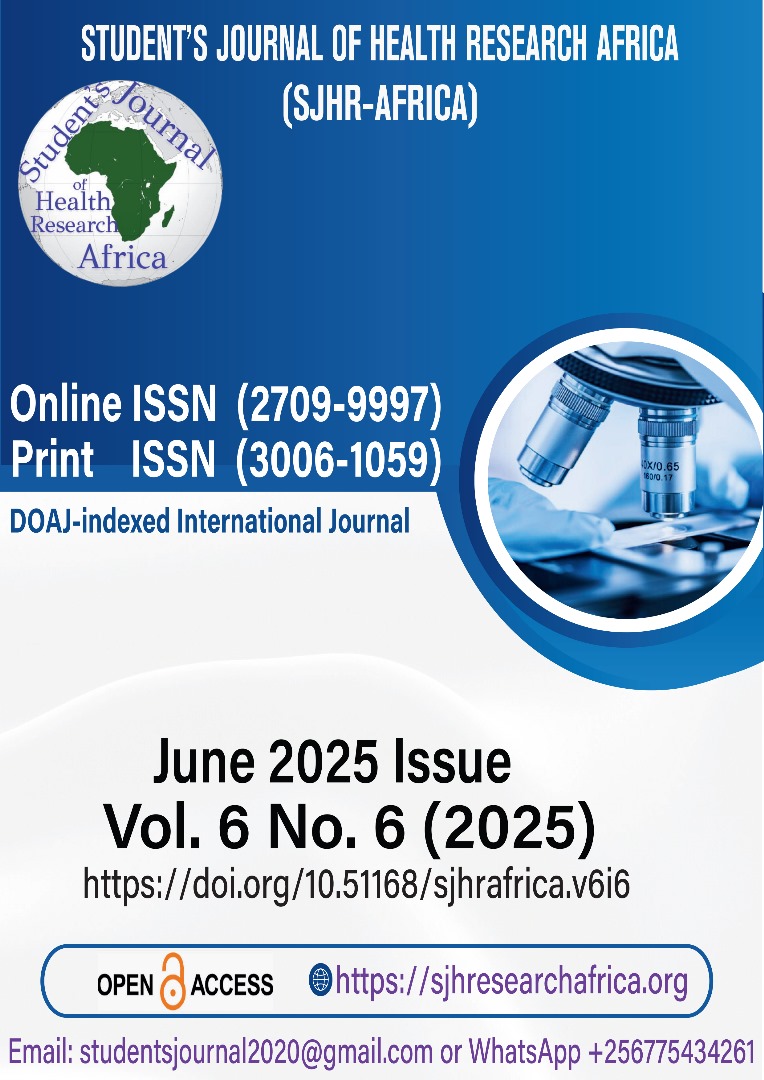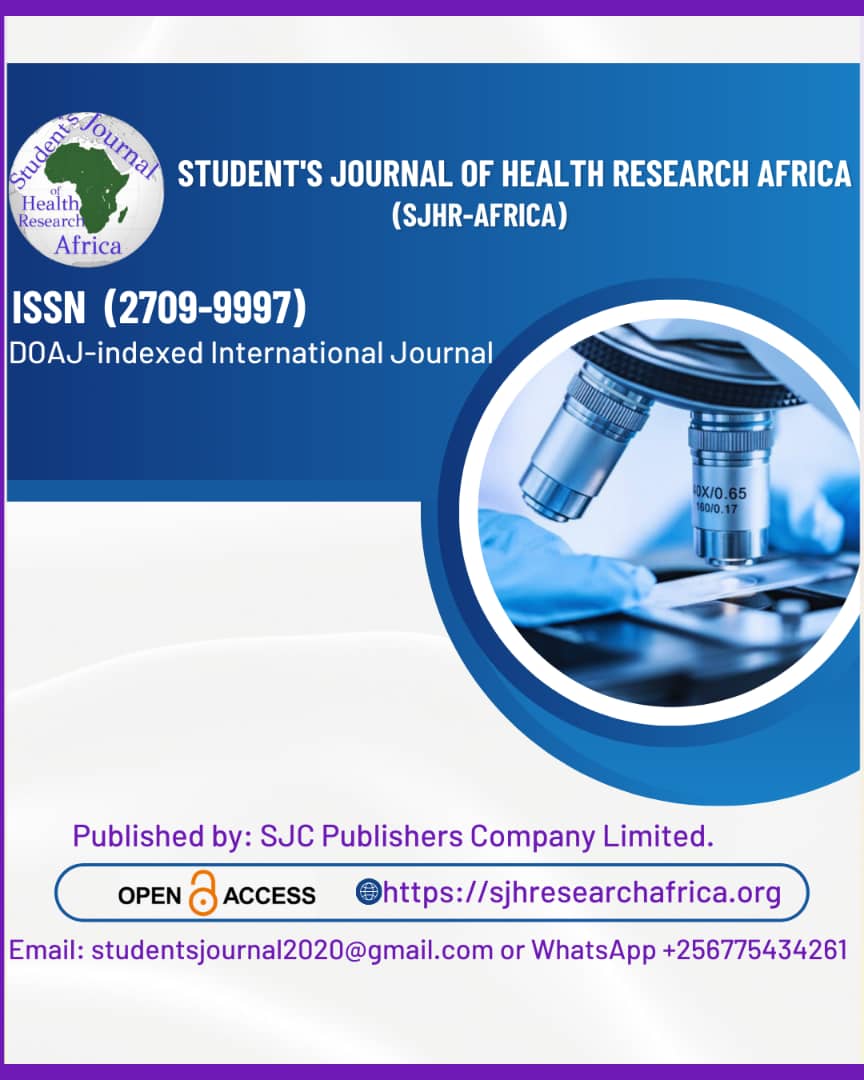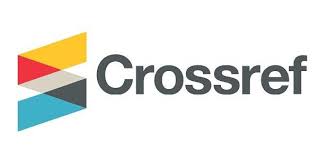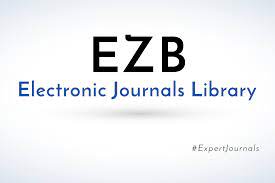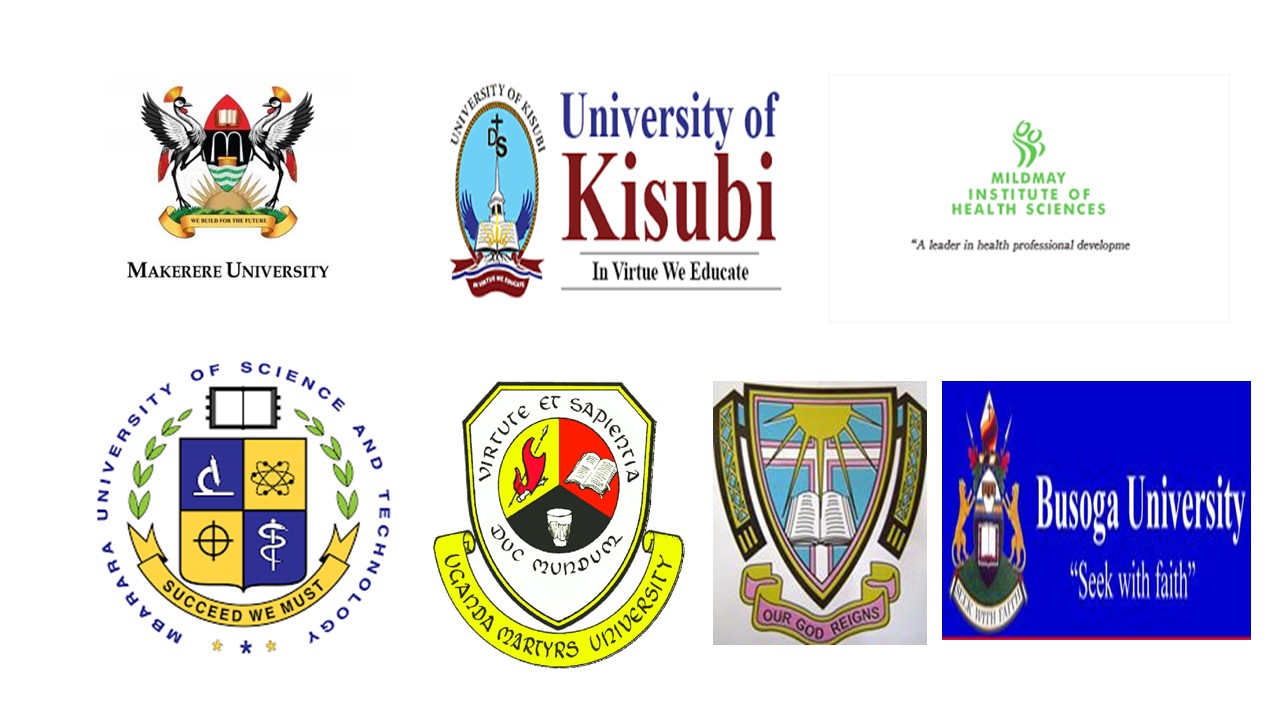THE MODERATING EFFECTS OF PERSONAL FACTORS ON HEALTH-SEEKING BEHAVIOURS AND UTILISATION OF SEXUAL AND REPRODUCTIVE HEALTH SERVICES AMONG ADOLESCENTS IN BUSOGA REGION, UGANDA: A CROSS-SECTIONAL STUDY.
DOI:
https://doi.org/10.51168/sjhrafrica.v6i6.1751Keywords:
Adolescents, Uganda, Sexual and Reproductive Health, Health-Seeking Behaviour, ModerationAbstract
Background
Adolescents in Uganda face substantial barriers to sexual and reproductive health (SRH) service utilization, influenced by both individual and structural factors. This study assessed how personal characteristics, specifically age, employment status, and travel time, moderate the relationship between health-seeking behaviors and SRH service use in the Busoga region.
Methods
A cross-sectional study was conducted in 2024 among 408 adolescents aged 13–19 years using structured questionnaires. Structural Equation Modelling (SEM) was applied to examine associations and moderation effects.
Results
Positive health-seeking attitudes predicted adolescents’ intentions to use SRH services (β = 2.310, p < 0.001), while age (β = -0.090, p = 0.002) and employment (β = -0.453, p = 0.002) negatively moderated this relationship. Travel time reduced service use (β = -0.272, p < 0.001), but service preferences helped offset this effect (β = 0.093, p < 0.001). Media exposure, particularly through radio, positively moderated the relationship between attitudes and current SRH utilization (β = 0.072, p < 0.001).
Conclusions
Positive health-seeking attitudes significantly predicted adolescents’ intentions to use SRH services. However, this effect was weakened by older age and employment. While longer travel time reduced service utilization, strong service preferences helped offset this barrier.
Recommendations
To improve SRH service utilization among adolescents in Uganda’s Busoga region, programs should be more adolescent-responsive. Key actions include: training providers in adolescent-friendly care, expanding mobile and community outreach, utilizing trusted media such as radio to promote positive attitudes, and tailoring interventions to meet the specific needs of subgroups, including working, rural, and older adolescents.
References
Andersen, R. (1995). Revisiting the behavioral model and access to medical care: Does it matter? Journal of Health and Social Behavior, 36(1), 1–10.
Aragaw, F. M., Teklu, R. E., Belay, D. G., Negash, W. D., Fetene, S. M., Alemu, T. G., Eshetu, H. B., Fentie, E. A., Shewarega, E. S., & Asmamaw, D. B. (2023). Individual and community level predictors of women’s autonomy in health care decision-making among youth in East African countries: A multilevel analysis. BMJ Open, 13(6), e066975.
Asiimwe, J. B., Kibira, S. P. S., Matsubara, C., Otai, J., Katusiime, B., & Nansubuga, E. (2020). Barriers to adolescent sexual and reproductive health services in Uganda: A qualitative study. BMC Public Health, 20, 110. https://doi.org/10.1186/s12889-020-8259-3
Athumani, K. F., & Mboineki, J. F. (2025). Healthcare facility factors associated with health-seeking behavior among secondary school students in the Dodoma region: An analytical cross-sectional study. Frontiers in Public Health, 13, 1457318.
Bukenya, J. N., Ssekamatte, T., Komuhendo, R., & Stillman, M. (2020). Young people's access to sexual and reproductive health services in Uganda: Understanding barriers and facilitators. Reproductive Health, 17, Article 166. https://doi.org/10.1186/s12978-020-01008-8
Byrne, B. M. (2013). Structural equation modeling with AMOS: Basic concepts, applications, and programming (2nd ed.). Routledge.
Chandra-Mouli, V., Lane, C., & Wong, S. (2015). What does not work in adolescent sexual and reproductive health: A review of evidence on interventions commonly accepted as best practices. Global Health: Science and Practice, 3(3), 333–340. https://doi.org/10.9745/GHSP-D-15-00126
Denno, D. M., Hoopes, A. J., & Chandra-Mouli, V. (2015). Effective strategies to provide adolescent sexual and reproductive health services and to increase demand and community support. Journal of Adolescent Health, 56(1), S22–S41. https://doi.org/10.1016/j.jadohealth.2014.09.012
Hu, L. T., & Bentler, P. M. (1999). Cutoff criteria for fit indexes in covariance structure analysis: Conventional criteria versus new alternatives. Structural Equation Modeling: A Multidisciplinary Journal, 6(1), 1–55. https://doi.org/10.1080/10705519909540118
Jacobs, C., Mwale, F., Mubanga, M., Kasonde, M., Saili, A., Mukonka, R., Mumbi Mwilu, L., & Munakampe, M. N. (2023). Perceptions of youth-friendly sexual and reproductive health services in selected higher and tertiary education institutions of Zambia: A qualitative study on the perspectives of young people and healthcare providers. PLOS Global Public Health, 3(11), e0002650. https://doi.org/10.1371/journal.pgph.0002650
Kline, R. B. (2016). Principles and practice of structural equation modeling (4th ed.). The Guilford Press.
Klu, D., Gyapong, M., Agordoh, P. D., Azagba, C., Acquah, E., Doegah, P., Ofosu, A., & Ansah, E. K. (2023). Adolescent perception of sexual and reproductive health rights and access to reproductive health information and services in Adaklu district of the Volta Region, Ghana. BMC Health Services Research, 23(1), 1456. https://doi.org/10.1186/s12913-023-10360-4
McGranahan, M., Bruno-McClung, E., Nakyeyune, J., Nsibirwa, D. A., Baguma, C., Ogwang, C., Serunjogi, F., Nakalembe, J., Kayaga, M., Sekalala, S., & Oyebode, O. (2021). Realising sexual and reproductive health and rights of adolescent girls and young women living in slums in Uganda: A qualitative study. Reproductive Health, 18(1), 125. https://doi.org/10.1186/s12978-021-01192-w
Ninsiima, L. R., Chiumia, I. K., & Ndejjo, R. (2021). Factors influencing access to and utilisation of youth-friendly sexual and reproductive health services in sub-Saharan Africa: A systematic review. Reproductive Health, 18(1), 135. https://doi.org/10.1186/s12978-021-01170-2
Okyere, J., Yeboa, N. K., Nikoi, C., Owusu-Amoako, M., Ferka, L., Nurzhynska, A., & Amo-Adjei, J. (2024). Adolescent sexual and reproductive health needs and utilisation of health services in the Bono East Region, Ghana. Reproductive Health, 21(1), 87. https://doi.org/10.1186/s12978-024-01648-0
Otwombe, K., Dietrich, J., Laher, F., Hornschuh, S., Nkala, B., Chimoyi, L., Kaida, A., Gray, G. E., & Miller, C. L. (2015). Health-seeking behaviours by gender among adolescents in Soweto, South Africa. Global Health Action, 8(1), 25670. https://doi.org/10.3402/gha.v8.25670
Rosenstock, I. M. (1974). Historical origins of the health belief model. Health Education Monographs, 2(4), 328–335. https://doi.org/10.1177/109019817400200403
Shaikh, B. T., & Hatcher, J. (2005). Health seeking behaviour and health service utilisation in Pakistan. Journal of Public Health, 27(1), 49–54. https://doi.org/10.1093/pubmed/fdh207
Sidamo, N. B., Kerbo, A. A., Gidebo, K. D., & Wado, Y. D. (2023). Socio-ecological analysis of barriers to access and utilisation of adolescent sexual and reproductive health services in sub-Saharan Africa: A qualitative systematic review. Open Access Journal of Contraception, 14, 103–118. https://doi.org/10.2147/OAJC.S430920
Stein, C. M., Morris, N. J., & Nock, N. L. (2011). Structural equation modeling. In D. J. Balding, M. Bishop, & C. Cannings (Eds.), Statistical human genetics: Methods and protocols (pp. 495–512). Humana Press. https://doi.org/10.1007/978-1-59745-583-1_20
Uganda Bureau of Statistics (UBOS). (2024). National population and housing census 2024. UBOS.
Wado, Y. D. (2018). Women's autonomy and reproductive health-care-seeking behavior in Ethiopia. Women & Health, 58(7), 729–743. https://doi.org/10.1080/03630242.2017.1353572
World Health Organization. (2018). Global accelerated action for the health of adolescents (AA-HA!): Guidance to support country implementation. World Health Organization. https://apps.who.int/iris/handle/10665/260231
Downloads
Published
How to Cite
Issue
Section
License
Copyright (c) 2025 Noah Robert Nyende, Dr. Frank Pio Kiyingi, Professor Miph Musoke

This work is licensed under a Creative Commons Attribution-NonCommercial-NoDerivatives 4.0 International License.

